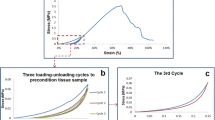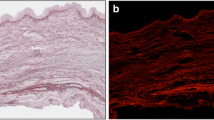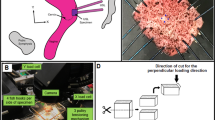Abstract
The aim of this study was to explore the relationship between biomechanical properties and the occurrence of pelvic organ prolapse (POP) through analysis on biomechanical properties of vaginal tissue. The biopsy specimens were obtained from 43 patients undergoing transvaginal hysterectomy, who were assigned into premenopausal POP, postmenopausal POP, premenopausal control and postmenopausal control groups. Tissue specimens were biomechanically assessed by a purpose-built tissue puller system, and stress–strain curves were digitally recorded. The Young’s modulus, Poisson’s ratio, maximum elongation, maximum fracture of vaginal tissue were 9.45 ± 0.70, 0.43 ± 0.01, 1.50 ± 0.02, 0.60 ± 0.02 in premenopausal POP group; 12.10 ± 1.10, 0.39 ± 0.01, 1.14 ± 0.05, 0.27 ± 0.03 in postmenopausal POP group; 6.65 ± 1.48, 0.46 ± 0.01, 1.68 ± 0.11, 0.79 ± 0.05 in premenopausal control group and 10.26 ± 1.10, 0.42 ± 0.01, 1.37 ± 0.04, 0.42 ± 0.03 in postmenopausal control group. There was significant difference in biomechanical properties between premenopausal POP group and premenopausal control group (p < 0.01). There was significant difference in biomechanical properties between postmenopausal POP group and postmenopausal control group (p < 0.01). Biomechanical properties in POP group were significantly lower than that in control group, suggesting that degeneration of biomechanical properties in pelvic support construction might lead to the occurrence of POP.
Similar content being viewed by others
References
Jelovsek JE, Barber MD, Paraiso MF, Walters MD (2005) Functional bowel and anorectal disorders in patients with pelvic organ prolapse and incontinence. Am J Obstet Gynecol 193(6):2105–2111
Woodman PJ, Swift SE, O’boyle AL, Valley MT, Bland DR, Kahn MA, Schaffer JI (2006) Prevalence of severe pelvic organ prolapse in relation to job description and socioeconomic status: a multicenter cross-sectional study. Int Urogynecol J Pelvic Floor Dysfunct 17(4):340–345
Auwad W, Bombieri L, Adekanmi O, Waterfield M, Freeman R (2006) The development of pelvic organ prolapse after colposuspension: a prospective, long-term follow-up study on the prevalence and predisposing factors. Int Urogynecol J Pelvic Floor Dysfunct 17(4):389–394
Weber AM, Richter HE (2005) Pelvic organ prolapse. Obstet Gynecol 106(3):615–634
Tegerstedt G, Maehle-Schmidt M, Nyren O, Hammarstrom M (2005) Prevalence of symptomatic pelvic organ prolapse in a Swedish population. Int Urogynecol J Pelvic Floor Dysfunct 16(6):497–503
Lang JH (2005) Urogynecology and reconstructive pelvic surgery: past, present and future 2. Zhonghua Fu Chan Ke Za Zhi 40(3):145–147
Ettema GJC (1997) Mechanical behaviour of rat skeletal muscle during latiguing stretch-shorten cycle. Exp Physiol 82:107–119
Ettema GJC, Goh JTW, Forwood MR (1998) A new method to measure elastic properties of plastic-viscoelastic connective tissue. Med Eng Phys 20:308–314
Wong MY, Harmanli OH, Agar M, Dandolu V, Grody MH (2003) Collagen content of nonsupport tissue in pelvic organ prolapse and stress urinary incontinence. Am J Obstet Gynecol 189(6):1579–1597
FitzGerald MP, Mollenhauer J, Hale DS, Benson JT, Brubaker L (2000) Urethral collagen morphologic characteristics among women with genuine stress incontinence. Am J Obstet Gynecol 182:1565–1574
Norton P, Boyd C, Ekman G, Malmstrom A, Ulmsten U (1994) Decreased collagen synthesis in stress incontinent women. Obstet Gynecol 84:583–586
Falconer C, Ekman G, Malmstrom A, Ulmsten U (1994) Decreased collagen synthesis in stress incontinent women. Obstet Gynecol 84:583–586
Rechberger T, Postawski K, Jakowicki JA, Gunja-Smith Z, Woessner JF (1998) Role of fascial collagen in stress urinary incontinence. Am J Obstet Gynecol 179:1511–1514
Ettema GJC, Goh JTW, Forwood MR (1998) A new method to measure elastic properties of plastic-viscoelastic connective tissue. Med Eng Phys 20:308–314
Bump RC, Mattiasson A, Bo K, Brubaker LT, Delancey JOL, Klarksor P et al (1996) The standardization of terminology of female pelvic organ prolapse and pelvic floor dysfunction. Am J Obstet Gynecol 175:10–17
Bai SW, Choe BH, Kim JY, Park KH (2002) Pelvic organ prolapse and connective tissue abnormalities in Korean women. J Reprod Med 47:231–234
Norton P, Boyd C, Deak S (1992) Collagen synthesis in women with genital prolapse or stress urinary incontinence. Neurourol Urodyn 11:300
Jackson SR, Avery CH, Tarlton JF et al (1996) Changes in metabolism of collagen in genitourinary prolapse. Lancet 347:1658–1661
Landon CR et al (1990) Mechanical properties of fascia during pregnancy: a possible factor in the development of stress incontinence of urine. Contemp Rev Obstet Gynecol 2:40–46
Adekanmi O et al (2005) Cystocele: Does anterior repair fail because of weak vaginal wall tissue? Int Urogynecol J 16(Suppl 2):S72 (Abstract)
Goh JT (2002) Biomechanic properties of prolapse vaginal tissue in pre and post menopausal women. Int Urogynecol J 13(2):76–79
Cosson M, Lambaudie E, Boukerrou M et al (2004) A biomechanical study of the strength of vaginal tissue. Results on 16 post menopausal patients presenting with genital prolpase. Eur J Obstet Gynecol Reprod Biol 112(2):201–205
Author information
Authors and Affiliations
Corresponding author
Additional information
Grant Fujian Science & Technology Bureau Foundation No. 2000I1003.
Rights and permissions
About this article
Cite this article
Lei, L., Song, Y. & Chen, R. Biomechanical properties of prolapsed vaginal tissue in pre- and postmenopausal women. Int Urogynecol J 18, 603–607 (2007). https://doi.org/10.1007/s00192-006-0214-7
Received:
Accepted:
Published:
Issue Date:
DOI: https://doi.org/10.1007/s00192-006-0214-7




